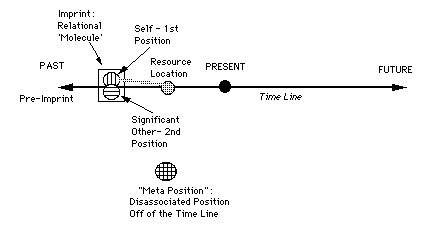The NLP Pattern of the Month: Re-Imprinting
by Robert Dilts.
An imprint is a significant experience or period of life from the past in which a person formed a belief or cluster of beliefs, often in relationship to one's identity. An imprint experience also often involves the unconscious role-modeling of significant others. The purpose of reimprinting is to find the resources necessary to change the beliefs and update the role-models that were formed (not simply to resolve the emotional issues associated with a particular event, as in the NLP technique of change personal history).
1. Identify the specific physical manifestation of the symptoms to be addressed. Stand in the physical location on your time line representing the present and face the future direction. Focus your attention on the physical expression of your symptoms, and any beliefs associated with them, and walk slowly backwards pausing at any location that seems to be relevant to the symptom or the accompanying beliefs. Keep moving back in time until you reach the earliest experience associated with the symptoms and/or the beliefs.
- Keeping in the associated or "regressed" state verbalize the cluster of generalizations or beliefs that were formed from the experience(s). Make sure you speak in first person, present tense; i.e., "I am feeling..."
- Take a step backwards to a time before initial imprint experience. When you do so you should feel differently - as if the imprint had not yet effected you either mentally or physically.
2. Step off of the time-line and return to the present and look back at the imprint experience from 'meta-position'.
- Notice the effect that earlier experience has had on your life. Verbalize any other generalizations or beliefs that were formed as a result of the imprint experience. (Beliefs are often formed "after the fact.") This time, speak about the events you experienced in third person, past tense; i.e., "He/She (or 'The younger me') thought that..."
- Find the positive purpose or secondary gain of the symptoms or responses formed at the imprint experience. What positive function did the symptoms serve in relations to those past events?

3. Identify any significant others involved in the imprint. [Some symptoms may actually come from the role modeling of a significant other]. The significant others do not necessarily need to have been physically present during the event or period. Sometimes an imprint occurs because the significant other was somewhere else at the time of the imprinting situation (and thus became 'internalized'.
- Associate into each of the significant others (2nd position) and experience the imprint situation from their perceptual position. Describe their experiences using first person language.
- Step out of their perceptual position to a point off the the time line (3rd position) and find the positive intention of their actions and responses.
4. For each of the people involved in the imprint experience:
- Identify the resources or choices that the person needed back then and did not have but that you do have available now. Remember that you need not limit yourself to the capabilities that you or the significant others had at that time. So long as you (not the significant others) have those resources available now you may use them to help change that experience. [Make sure the resource is at the appropriate logical level to address the needs of the person - i.e., belief, identity, spiritual.] Sometimes a single resource is needed for the whole system.
- Step onto your time-line at the location where you most strongly experienced having that resource and relive as fully as possible what it feels sounds and looks like. "Anchor" this experience by symbolically representing the resource as a kind of energy, light or sound.
- Still standing in the resource location, "transmit" the resource back through time to each person in the system that needed it. This may done metaphorically through the energy light or sound.
- When you sense that the "associative connection" has been made through the "anchor," step off of the time-line, walk back to the imprint experience, step into the position of the person who needed the resource and relive the imprint experience from that person's point of view incorporating the needed resource. You may continue to use your symbolic "anchor" to bring the resource into that perspective.
- Associate once again into your own perceptual position within the imprint experience, and update or modify the beliefs and generalizations you would now choose to make from the experience. Verbalize them from first person, present tense.
Repeat this procedure for each of the significant people involved in the imprint experience.

5. Identify the most important resource or belief that you would have needed as your younger self. "Anchor" that resource and take it back to the location on the time-line before the imprint occurred. Take the resource into your younger self and walk all the way up your time-line to the present, experiencing the changes made by the reimprinting.
Also see the Article of the Month or the Archives if you are interested in checking out NLP in more depth.
For information on Robert Dilts’ products and services, please see Upcoming Seminars or Robert’s Product Page or return to Home Page.
If you have problems or comments concerning our WWW service, please send e-mail to the following address: michaelp@bowsprit.com.
This page, and all contents, are Copyright © 1998 by Robert Dilts., Santa Cruz, CA.


